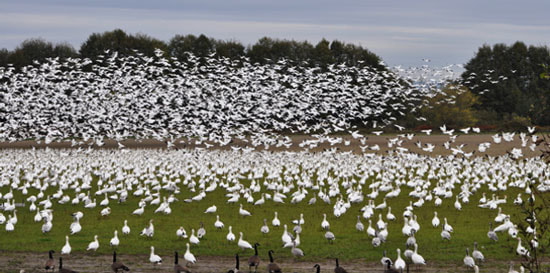|
I like to feature animals that make an appearance in my books, and today's critter makes a most spectacular appearance in Profusion. In fact, you could even say it's a save-the-world kind of appearance! Imagine standing in the middle of a flock of over a million white, cackling geese spread out over the ground for as far as you can see. Then imagine that something triggers the birds to take off. In a roar of millions of wings and high-pitched voices, the geese lift from the ground and take to the sky, circling above you like a white tornado. Yes, the scene above takes place in Profusion, but this is something you can also experience in real life. At least you can if you visit the North American migration corridors of the lesser snow goose or greater snow goose. They migrate in groups of hundreds of thousands, and their movements are one of the most impressive migration events on Earth. The hunting of snow geese was stopped in 1916 because their numbers had been drastically reduced. By 1975 their numbers had recovered, and hunting them was reinstated. But since the 1970s, their numbers have increased by 300%. They are getting so overpopulated that huge flocks of them are inflicting irreparable damage to the fragile tundra habitats where they feed and nest in the summers. Amazing facts about the Snow Goose Snow geese like to migrate in groups. Often they will be in flocks of thousands. In fact, if you are near one of the places where they rest in large numbers, it isn't unusual to see flocks of several hundred thousand. I have been at the Grand Pass Conservation Area here in Missouri on days when there are 1.2 million gathered in one area. When they come in to land, it looks like a giant, gently swirling tornado. Check out this video showing some great scenes of migrating flocks. The blue goose used to be considered a separate species, but now we know it is just a color variation of the snow goose that is caused by only one gene. The blue gene is slightly dominant to the white gene. If two white geese mate, they will have all white offspring. But if a white and blue goose mate, usually all the offspring will be blue (although they may have white bellies). And if two blue geese mate, they will have mostly blue, but some white geese. What I find interesting is that, at least here in the Midwest US, the proportion of blue geese has increased in the ten years I have been observing them. Now it seems as if about 30% of each large flock is blue geese. See the comparison below. Snow goose goslings are very well developed when they hatch. They have soft downy feathers that immediately show whether they will turn out to be white or blue. And they can walk VERY well. In fact, in the arctic areas where they breed, the newly-hatched chicks can often walk with their parents up to 50 miles over a three-week period in order to find a better rearing area. Snow geese can live up to 27 years. One of the important ways biologists study them is to put metal bands on their feet. When hunters shoot these banded birds, they report the information to an online database, which allows biologists to better understand migration patterns, breeding behavior, and longevity. Snow geese are poop factories. Food passes through their digestive tract in only an hour or two. This means they can poop up to 15 times per hour. And they are especially productive (poopwise) when feeding on rhizomes, which are high in fiber (and the geese swallow lots of mud as they eat them). Snow geese have become so abundant in the last few decades that they are causing severe damage to their tundra feeding grounds. Why? Because the birds feed on the grasses. And now that the flocks are larger than ever, they run out of grasses and start feeding on the underground rhizomes (specialized underground stems) of the grass, making it so the grass cannot grow back. They are turning arctic grasslands into salty mud flats. In an attempt to control the exploding population, the US Fish and Wildlife Service in 1999 initiated new rules that allowed 24 US states to create opportunities for hunting enthusiasts to harvest as many of the birds as possible. I happen to enjoy snow goose hunting, but it isn't an easy sport. Snow geese are notoriously difficult to decoy, and it takes hundreds of decoys and lots of hard work. See image below. Unfortunately, these efforts are not decreasing the population much. So, the Snow Goose deserves a place in the F.A.H.O.F. (Fizzing Animal Hall of Fame). FUN FACT: Fizzing is one of several words associated with a sound that have gradually become adjectives implying that something is excellent. Ripping is another example (I had a ripping time last night). So, in other words, fizzing is another way to say awesome. Photo Credits:
Snow Goose Flock #1 - George C. Reifel Migratory Bird Sactuary Snow Goose Flock #2 - Mike Hollingshead Snow Goose, Blue Goose - Paul Higgins Snow Goose Hunting Sunrise - Stan C. Smith
0 Comments
Leave a Reply. |
Stan's Cogitations
Everyone needs a creative outlet. That's why I write. Archives
July 2024
|





 RSS Feed
RSS Feed